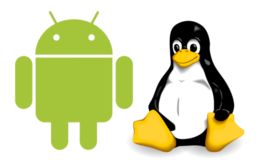577 words [ 71 Screenshots ] [ 24 Versions ] [ 4 Weblinks ] - Last update: 2023-12-22 Page created: 2008-09-28 [SB]
Android OS
 The android platform was founded by Google and offers on the base the Linux kernel 2.6 a uniform interface for mobile equipment and programmes. Through this it is easily to port and is programmed in Java. After the conversion into the own binary program format Dalvik (.dex) it is not compatible to Java any more. Advantage is the faster execution and the lower memory footprint of programmes than in pure Java. Every Dalvik application is executed in a Dalvik VM of its own. Applications can access all equipment functions. This makes it possible for the programmer to make innovative programmes which offers the user high value by the combination of all sorts of data sources with the equipment functions.
The android platform was founded by Google and offers on the base the Linux kernel 2.6 a uniform interface for mobile equipment and programmes. Through this it is easily to port and is programmed in Java. After the conversion into the own binary program format Dalvik (.dex) it is not compatible to Java any more. Advantage is the faster execution and the lower memory footprint of programmes than in pure Java. Every Dalvik application is executed in a Dalvik VM of its own. Applications can access all equipment functions. This makes it possible for the programmer to make innovative programmes which offers the user high value by the combination of all sorts of data sources with the equipment functions.
The Eclipse IDE with an official plugin is used for the development. The operating system Android for Smartphones is supported by the Open Handset Alliance. Including more than 30 communication provider, equipment and semiconductor manufacturers as well as software companies. Because Android is an open platform in the meaning of the software and product development the source code shall be available completely at a later time and is in opposite with the market leading closed operating systems Symbian, Palm OS and Windows Mobile.
Android include C/C++ function libraries used by different parts of the operating system.
- Surface manager for 2D and 3D even overlay display
- System C library, specialized for Linux-based devices (BSD implementation)
- SGL, 2D graphic system
- 3D libraries, based on OpenGL ES 1.0 APIs with hardware or software accelerated 3D display
- Media libraries for playback and record of audio, graphic and video formats (MPEG4, H.264, MP3, AAC, AMR, JPG, PNG)
- LibWebCore, Android internet browser
- FreeType, for representing of bitmap and vector fonds
- SQLite, an efficient and slim relational database for all applications
The Android SDK is available for Linux, MacOS and Windows. It contains an emulator with the surface of Android to try applications. After unpacking the SDK the emulator can be found in the subdirectory " oolsemulator.exe" that shows a HTC Smartphone with keyboard.
Standard programs for e-mail, SMS, contacts, calendar, road maps, internet browser and others are preinstalled.
The first Google Android Developer Challenge (ADC) started in April 2008 for engaged programmers to realize and present ideas. Approximately 1,800 programmes were submitted and 20 honoured with a price money under the best 50. Part of the best applications are for example cab4me by combination of Google Maps, GPS signal and a database to send a taxi in the simplest mode by click to the current position on the map. Or GoCart which reads the bar code of goods with the mobile telephone camera and looks over onlineshops and registered shops in the circumference for the best price.
Google creates a sales platform for Smarthone applications with Android Market. At first the market place is provided free of charge. The first Android mobile telephone cames from the taiwanese manufacturer HTC with the T-Mobile G1 smartphone starting at October 22nd, 2008 in the USA and at the beginning of 2009 in Germany. The Android Market was renamed in Google Play on 6th March 2012.
The market research group Gartner, Inc. released a press news about the worldwide market share of smartphone ventors and operating systems on 19th August 2016. In the 2nd quarter 2016, 296.9 million Android units have been sold, this represents a market share of 86.2%. The Android operating system increased his share, in 2nd quarter 2015 the market share was 82.2% with 271.6 million units sold.
Date - Version
2008 Aug. 18 - Android 0.9 SDK beta available2008 Sept. 23 - Android 1.0 SDK Release 1 available2008 Oct. 21 - Android 1.0 source code released, Linux kernel version 2.6.252008 Oct. 22 - Android 1.0 (Base), device on the market (USA), 2009 in Germany2009 April 25 - Android 1.5 (Cupcake), new Linux kernel version 2.6.272009 Sept. - Android 1.6 (Donut), new Linux kernel version 2.6.292009 Oct. - Android 2.0 (Eclair)2010 May - Android 2.2 (Froyo)2010 Dec. - Android 2.3 (Gingerbread)2011 Feb. - Android 3.0 (Honeycomb)2011 Oct. - Android 4.0 (Ice Cream Sandwich)2012 July - Android 4.1 (Jelly Bean)2013 Oct. - Android 4.4 (KitKat)2014 Nov. - Android 5.0 (Lollipop)2015 Oct. - Android 6.0 (Marshmallow)2016 Aug. - Android 7.0 (Nougat)2017 Aug. - Android 8.0 (Oreo)2018 Aug. - Android 9 (Pie)2019 Sept. - Android 10 (Quince Tart)2020 Sept. - Android 11 (Red Velvet Cake)2021 Oct. - Android 12 (Snow Cone)2022 Aug. - Android 13 (Tiramisu)2023 Oct. - Android 14 (Upside Down Cake)-- - Android 15 (Vanilla Ice Cream)






































































